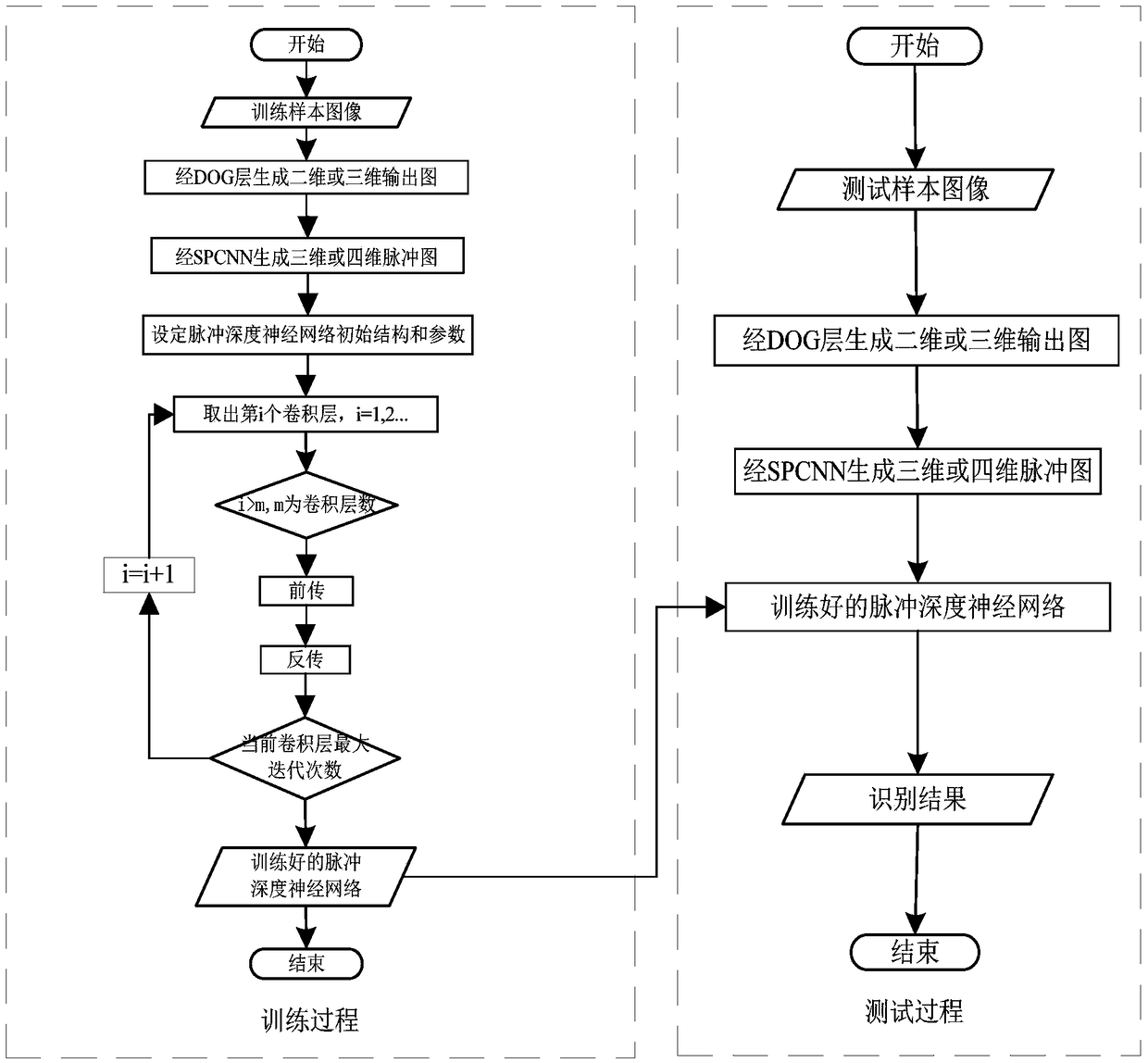Improved image classification method based on impulse deep neural network
A pulse depth, neural network technology, applied in biological neural network model, neural architecture, image enhancement and other directions, can solve the problem of back propagation algorithm without biological root, unable to generate time channel, not in line with biological characteristics, etc.
- Summary
- Abstract
- Description
- Claims
- Application Information
AI Technical Summary
Problems solved by technology
Method used
Image
Examples
Embodiment 1
[0073] The images in this embodiment come from the Caltech 101 data set. The data set contains 101 categories, a total of 8677 images. We select two categories of faces and motorcycles, and select 200 images for each category as a training set, and 198 images for each category as a test set. exist figure 1 , 2 In , an improved spiking deep neural network image classification method consists of the following steps:
[0074] (1) Image preprocessing
[0075] Apply DOG layer and simplified pulse-coupled neural network to preprocess the image, the specific steps are as follows:
[0076] (a) Select an image from the image data set and normalize it to 160 pixels × 250 pixels and grayscale it;
[0077] (b) Generate DOG layer Gaussian filter
[0078]
[0079] In the formula, filt is the Gaussian filter of the DOG layer, s1 and s2 are the standard deviation of the Gaussian filter, and the values are 1 and 2 respectively, and x is a 7×7 matrix, in which the elements of each row...
Embodiment 2
[0118] The images in this embodiment come from the MNIST data set, which contains 10 categories of handwritten digits 0 to 9, a total of 70,000 images, 60,000 images in the training set, and 10,000 images in the test set. We randomly select 500 images of each type from the training set as the training set, a total of 5000 images, and all the test images as the test set. figure 2 Among them, the image classification method of the improved pulse deep neural network of this implementation is made up of the following steps:
[0119] (1) Image preprocessing
[0120] Apply DOG layer and simplified pulse-coupled neural network to preprocess the image, the specific steps are as follows:
[0121] (a) Select an image from the image data set and normalize it to 28 pixels × 28 pixels and grayscale it;
[0122] (b) Generate DOG layer Gaussian filter
[0123]
[0124] In the formula, filt is the Gaussian filter of the DOG layer, s1 and s2 are the standard deviation of the Gaussian fi...
Embodiment 3
[0164] The images in this embodiment come from the Caltech 101 data set. The data set includes 101 categories with a total of 8677 images. We select two categories of airplanes and motorcycles. Each category selects 200 images as a training set, and each category contains 198 images as a test set. . An improved spiking deep neural network image classification method consisting of the following steps:
[0165] (1) Image preprocessing
[0166] Apply DOG layer and simplified pulse-coupled neural network to preprocess the image, the specific steps are as follows:
[0167] (a) Select an image from the image data set and normalize it to 160 pixels × 250 pixels and grayscale it;
[0168] (b) Generate DOG layer Gaussian filter
[0169]
[0170] In the formula, filt is the Gaussian filter of the DOG layer, s1 and s2 are the standard deviation of the Gaussian filter, and the values are 1 and 2 respectively, and x is a 7×7 matrix, in which the elements of each row are 1 to 7 arra...
PUM
 Login to View More
Login to View More Abstract
Description
Claims
Application Information
 Login to View More
Login to View More - R&D
- Intellectual Property
- Life Sciences
- Materials
- Tech Scout
- Unparalleled Data Quality
- Higher Quality Content
- 60% Fewer Hallucinations
Browse by: Latest US Patents, China's latest patents, Technical Efficacy Thesaurus, Application Domain, Technology Topic, Popular Technical Reports.
© 2025 PatSnap. All rights reserved.Legal|Privacy policy|Modern Slavery Act Transparency Statement|Sitemap|About US| Contact US: help@patsnap.com



